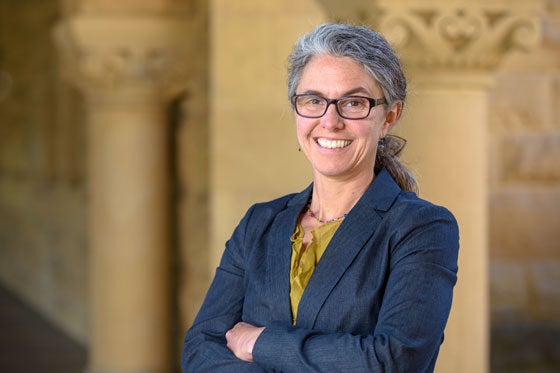Vice Provost Susie Brubaker-Cole talks about Stanford’s students
Seven months ago, Vice Provost for Student Affairs Susie Brubaker-Cole left Oregon State University to return to Stanford, where she served as associate vice provost for undergraduate education from 1999 to 2008 and as a resident fellow. Today, she oversees more than 25 offices and centers that offer resources, advising and support to 16,000 Stanford undergraduate and graduate students.
Brubaker-Cole reflects on the challenges confronting students—particularly those related to mental health, well-being and alcohol—and discusses initiatives her division is pursuing to enhance inclusiveness and belonging on campus.
What has been most exciting about being back at Stanford?
The community: People are caring, optimistic, engaged and conscientious. The will to act for a greater good is everywhere and infectious.
What are the challenges facing Stanford students?
There are three major ones. First, students struggle with mental health and well-being. We are seeing more instances where students need assistance, and many of those are cases of a higher acuity. For instance, the caseload for undergraduate residence deans is up 57 percent compared to five years ago, and many of these cases are urgent. Our students are accomplished and feel the pressures of excelling as students, but they are also affected by the volatile, unstable and changing world we live in. Many also do not feel integrated in our community. Students of color, first-generation students and low-income students in particular share that they experience the dominant Stanford culture as one that is not about their communities or identities.
Affordability is also a major source of stress. Those with low-income backgrounds struggle to access opportunities that cost more, or they find they need to work one or two jobs to meet expenses. We have a responsibility to make sure all opportunities are accessible, regardless of financial resources. We do that through the Opportunity Fund, which is available through the Diversity and First-Gen Office, but we need to do more.
The third issue is that many students feel the university is not yet truly welcoming and inclusive. There are certainly many spaces of true inclusion, especially through the community centers, which create a sense of belonging for students from historically marginalized communities. But we need to do more, particularly in classroom and residential settings.
You prioritized communicating with students during the past year. Why and what have you done?
Students shared with me immediately upon my arrival that they weren’t sure that they trusted the university. They felt there had not been enough bilateral flow of information. We increased opportunities for communication, knowing that if we don’t listen to students, we risk designing the wrong educational and living experience for them. One of the contributions I hope I make is as a translator for student experiences to senior administrators across campus.
In my short seven months, I have heard a commitment to transparency from all levels of the university. The president and provost’s blog, Notes from the Quad, is evidence, as are, for instance, the office hours held by the president and provost and the presence of students on university committees. I also host office hours for students in Student Affairs.
What are some of the initiatives that your staff has undertaken?
One initiate that doesn’t sound interesting at first blush, but is crucial, is “House in Order.” It recognizes that so many things in Student Affairs happen behind the scenes, but are essential to the smooth running of the university and excellent student experiences. They range from work at front desks to IT systems to registration to the way we manage our resources. Through this initiative, we seek excellence in everything we do.
Another is an initiative in collaboration with the 2017-18 ASSU leadership to address the harmful consequences of alcohol abuse. The goal is to ensure the safety of students and to reduce harmful behavior. The success of that initiative depends on the involvement of students. If we want to shift the drinking culture on campus, we have to do that hand-in-glove with students.
What are your priorities for the 2018-19 academic year?
We are launching four task forces that seek to create positive change in areas we have defined as important over the next five to seven years: Equity and Inclusion, Belonging and Community, Mental Health and Well-being, and Integrated Learning. We’ve given the initiative the official title “Our Most Important Work.” Each task force will define approaches and practices that we can put into play across the division, making the whole greater than the sum of its parts.
What advice do you have for parents of undergraduate students?
Stanford is hard, and it should be hard. Through doing things that are hard, we stretch and grow. As a result our students oftentimes need unconditional reinforcement. So, my advice to parents is that anytime you talk to your students, make sure there is some point in that conversation that you communicate to them, very simply, “I believe in you, unconditionally, through your highs and your lows.” It is empowering for students, and it helps them feel supported. They need to learn that challenge is part of life, and they need to believe that we all have the inner strength to make it through hard times.

